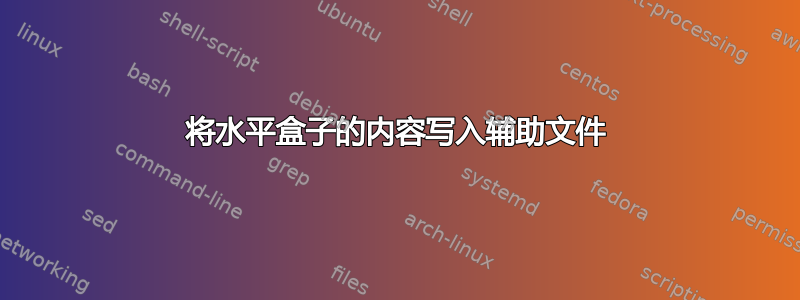
我知道 TeX 不能将 hbox 的内容写入辅助文件(重新解析盒子寄存器的内容)。
这意味着
\newwrite\foo
\immediate\openout\foo=\jobname.txt
\setbox0=\hbox{bar}
\immediate\write\foo{\box0}
写不出来但是 LuaTeX 能做到吗?我发现
\directlua{
n = tex.getbox(0)
}
但我不明白它n代表什么,以及我是否可以用它将框内容写入文件中。
答案1
编辑:这是一个适用于连字的新代码:
\documentclass{article}
\usepackage{fontspec}
\begin{document}
\setbox0=\hbox{Příliš žluťoučký \textit{kůň} úpěl \hbox{ďábelské} ódy, diffierence, difference}
\directlua{
% local fontstyles = require "l4fontstyles"
local char = unicode.utf8.char
local glyph_id = node.id("glyph")
local glue_id = node.id("glue")
local hlist_id = node.id("hlist")
local vlist_id = node.id("vlist")
local disc_id = node.id("disc")
local minglue = tex.sp("0.2em")
local usedcharacters = {}
local identifiers = fonts.hashes.identifiers
local function get_unicode(xchar,font_id)
local current = {}
local uchar = identifiers[font_id].characters[xchar].tounicode
for i= 1, string.len(uchar), 4 do
local cchar = string.sub(uchar, i, i + 3)
print(xchar,uchar,cchar, font_id, i)
table.insert(current,char(tonumber(cchar,16)))
end
return current
end
local function nodeText(n)
local t = {}
for x in node.traverse(n) do
% glyph node
if x.id == glyph_id then
% local currentchar = fonts.hashes.identifiers[x.font].characters[x.char].tounicode
local chars = get_unicode(x.char,x.font)
for _, current_char in ipairs(chars) do
table.insert(t,current_char)
end
% glue node
elseif x.id == glue_id and node.getglue(x) > minglue then
table.insert(t," ")
% discretionaries
elseif x.id == disc_id then
table.insert(t, nodeText(x.replace))
% recursivelly process hlist and vlist nodes
elseif x.id == hlist_id or x.id == vlist_id then
table.insert(t,nodeText(x.head))
end
end
return table.concat(t)
end
local n = tex.getbox(0)
print(nodeText(n.head))
local f = io.open("hello.txt","w")
f:write(nodeText(n.head))
f:close()
}
\box0
\end{document}
导致hello.txt:
Příliš žluťoučký kůň úpěl ďábelské ódy, diffierence, difference
原始答案:
示例中的变量n是节点列表。存在各种类型的节点,例如glyphs字符节点、glue间距节点或hlist您为 获得的类型\hbox。hlist包含子节点,这些子节点可在n.head属性中访问。然后,您可以循环此子列表以获取字形和胶水。
每种节点类型都可以通过n.id属性值来区分。特定节点类型和可能的属性在“8 节点”一章中描述。在这个特定示例中,我们只需要处理glyph和glue节点,但您应该记住节点列表是递归的,各种节点可以包含子列表,如hlist、等。您可以通过对当前节点属性vlist进行递归调用来支持它们。nodeTexthead
关于字形节点,char仅在使用 opentype 或 truetype 字体的情况下属性才包含 unicode 值,如果使用旧的 8 位字体,它只包含 8 位值,其实际编码取决于使用的字体编码,并且不容易将其转换为 unicode。
\documentclass{article}
\usepackage{fontspec}
\begin{document}
\setbox0=\hbox{Příliš žluťoučký \textit{kůň} úpěl \hbox{ďábelské} ódy}
\directlua{
local fontstyles = require "l4fontstyles"
local char = unicode.utf8.char
local glyph_id = node.id("glyph")
local glue_id = node.id("glue")
local hlist_id = node.id("hlist")
local vlist_id = node.id("vlist")
local minglue = tex.sp("0.2em")
local usedcharacters = {}
local identifiers = fonts.hashes.identifiers
local function get_unicode(xchar,font_id)
return char(tonumber(identifiers[font_id].characters[xchar].tounicode,16))
end
local function nodeText(n)
local t = {}
for x in node.traverse(n) do
% glyph node
if x.id == glyph_id then
% local currentchar = fonts.hashes.identifiers[x.font].characters[x.char].tounicode
table.insert(t,get_unicode(x.char,x.font))
local y = fontstyles.get_fontinfo(x.font)
print(x.char,y.name,y.weight,y.style)
% glue node
elseif x.id == glue_id and node.getglue(x) > minglue then
table.insert(t," ")
elseif x.id == hlist_id or x.id == vlist_id then
table.insert(t,nodeText(x.head))
end
end
return table.concat(t)
end
local n = tex.getbox(0)
print(nodeText(n.head))
local f = io.open("hello.txt","w")
f:write(nodeText(n.head))
f:close()
}
\box0
\end{document}
nodeText函数返回节点列表中包含的文本。在此示例中,它用于将\hbox内容打印到终端并写入文件。hello.txt
有关字体样式的基本信息,您可以尝试使用l4fontstyles模块,如下所示:
local fontstyles = require "l4fontstyles"
...
if x.id == glyph_id then
table.insert(t,char(x.char))
local y = fontstyles.get_fontinfo(x.font)
print(y.name,y.weight,y.style)


